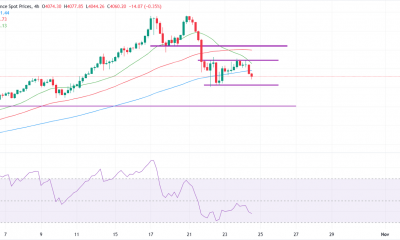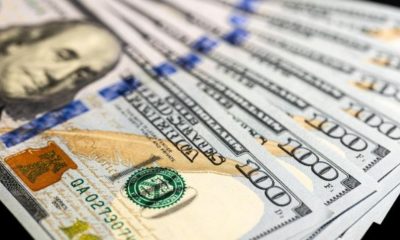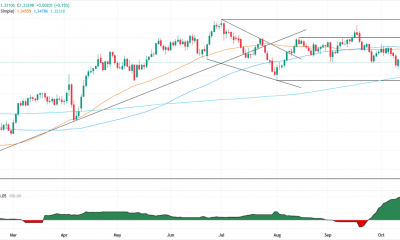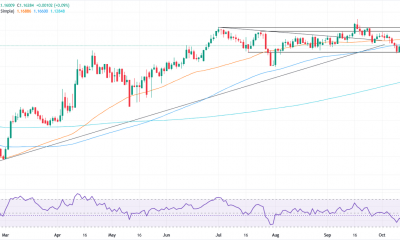

others
January NFP data set to test market doubts over Fed rate cuts in March – Crypto News
- US Nonfarm Payrolls are seen higher by 180K in January after December’s 216K jump.
- The US jobs report will likely impact the market pricing of the dovish Fed pivot and the US Dollar direction.
- The United States Bureau of Labor Statistics will publish the employment data at 13:30 GMT.
The highly-anticipated Nonfarm Payrolls (NFP) data from the United States (US) is due on Friday at 13:30 GMT. The US labor market report will be published by the Bureau of Labor Statistics (BLS) and is expected to have a significant influence on the US Dollar (USD) price direction.
What to expect in the next Nonfarm Payrolls report?
The Nonfarm Payrolls report is expected to show that the US economy added 180,000 jobs in the first month of 2024, down from a whopping 216,000 jobs created in December. The Unemployment Rate is seen ticking up from 3.7% in December to 3.8% in the reported period. A closely-watched measure of wage inflation, Average Hourly Earnings, is expected to rise 4.1% in the year through January, at the same pace as seen in December.
The US labor market data holds the key to gauging the timing and the pace of the US Federal Reserve (Fed) interest rate cut this year, especially after the US central bank pushed back expectations of a March rate cut following the conclusion of its two-day policy meeting on Wednesday.
The Fed left its benchmark interest rates unchanged at the 5.25% to 5.50% range for the fourth consecutive meeting on Wednesday, in line with the market expectations. The statement, however, was read as slightly hawkish, as it stated, “until it has increased confidence that inflation is moving sustainably toward 2 percent, the Committee does not anticipate it will be appropriate to lower the target range for the federal funds rate.”
During his post-policy meeting press conference, Fed Chair Jerome Powell said, “based on the meeting today, I would tell you that I don’t think it is likely that the Committee will reach a level of confidence by the time of the March meeting to identify March as the time to do that [lower interest rates], but that is to be seen.”
“It is probably not the most likely case, or what we would call the base case,” Powell added.
The probability of a March Fed rate fell steeply from about 50% at the start of the week to 35% after the Fed policy announcements, according to CME Group’s FedWatch Tool. Meanwhile, markets now see a 90% chance of the Fed lowering borrowing costs in May.
Previewing January’s jobs report, TD Securities (TDS) analysts said: “As it has become customary for Januarys, we look for a strong increase in payrolls at 230k next week.”
“The NFP’s annual benchmark and the update to seasonal factors will also add a wrinkle to this report,” the TDS analysts added.
Meanwhile, private sector employment in the US rose by 107,000 in January, data published by Automatic Data Processing (ADP) showed on Wednesday, below the 145,000 anticipated increase.
How will US January Nonfarm Payrolls affect EUR/USD?
The Nonfarm Payrolls, a significant indicator of the US labor market, will be published at 13:30 GMT. EUR/USD gained more than 1% in December and touched its highest level since July at 1.1140 before staging a technical correction to begin 2024. Traders gear up for a big volatility spike on the US jobs report, which could offer a fresh directional impetus to the main currency pair.
An encouraging NFP headline print, above 200,000, combined with a surprise uptick in wage inflation, could add credence to the Fed’s hawkish rhetoric, providing legs to the renewed US Dollar upside while weighing on EUR/USD. Conversely, the USD could come under renewed selling pressure should the data disappoint and reinforce March Fed rate cut bets. Following the Fed’s pushback on early rate cuts, a USD sell-off on a disappointing NFP figure could likely be short-lived.
Dhwani Mehta, Analyst at FXStreet, offers a brief technical outlook for EUR/USD:
“EUR/USD jumped off critical support at the horizontal 100-day Simple Moving Average (SMA), then aligned at 1.0780. The rebound saw the pair break through the key 200-day SMA at 1.0840. Despite the sharp upswing, the 14-day Relative Strength Index (RSI) remains below the 50 level, warranting caution for buyers.”
On the upside, EUR/USD buyers need a daily closing above the 21-day SMA at 1.0891 to sustain the upside. The next relevant topside barrier is envisioned at the 50-day SMA near 1.0920, above which a test of the 1.0950 psychological level cannot be ruled out. Any retracement in the pair could retest the 200-day SMA resistance-turned-support. Meanwhile, 100-day SMA could be the last line of defense for buyers.”
US yields have drifted a little lower following Monday’s announcement from the US Treasury of a smaller-than-expected quarterly borrowing requirement; lower yields may undercut support for the USD generally in the short run.
US Dollar price today
The table below shows the percentage change of US Dollar (USD) against listed major currencies today. US Dollar was the weakest against the Australian Dollar.
| USD | EUR | GBP | CAD | AUD | JPY | NZD | CHF | |
| USD | -0.01% | -0.02% | -0.09% | -0.32% | -0.06% | -0.12% | -0.10% | |
| EUR | 0.02% | -0.01% | -0.06% | -0.30% | -0.05% | -0.11% | -0.09% | |
| GBP | 0.03% | 0.01% | -0.05% | -0.30% | -0.04% | -0.10% | -0.08% | |
| CAD | 0.07% | 0.06% | 0.05% | -0.25% | 0.01% | -0.05% | -0.04% | |
| AUD | 0.32% | 0.31% | 0.30% | 0.25% | 0.25% | 0.19% | 0.22% | |
| JPY | 0.06% | 0.05% | 0.03% | -0.02% | -0.26% | -0.06% | -0.04% | |
| NZD | 0.13% | 0.11% | 0.11% | 0.05% | -0.19% | 0.06% | 0.02% | |
| CHF | 0.10% | 0.09% | 0.09% | 0.04% | -0.21% | 0.04% | -0.01% |
The heat map shows percentage changes of major currencies against each other. The base currency is picked from the left column, while the quote currency is picked from the top row. For example, if you pick the Euro from the left column and move along the horizontal line to the Japanese Yen, the percentage change displayed in the box will represent EUR (base)/JPY (quote).
-

 Blockchain1 week ago
Blockchain1 week agoAfrica Countries Pass Crypto Laws to Attract Industry – Crypto News
-
Cryptocurrency1 week ago
XRP News: Ripple Unveils ‘Ripple Prime’ After Closing $1.25B Hidden Road Deal – Crypto News
-

 Cryptocurrency1 week ago
Cryptocurrency1 week agoDOGE to $0.33 in Sight? Dogecoin Must Defend This Key Level First – Crypto News
-
others1 week ago
JPY soft and underperforming G10 in quiet trade – Scotiabank – Crypto News
-

 Blockchain1 week ago
Blockchain1 week agoXRP Price Gains Traction — Buyers Pile In Ahead Of Key Technical Breakout – Crypto News
-

 Blockchain1 week ago
Blockchain1 week agoISM Data Hints Bitcoin Cycle Could Last Longer Than Usual – Crypto News
-

 Cryptocurrency1 week ago
Cryptocurrency1 week agoWhat next for Avantis price after the 73% recovery? – Crypto News
-

 Technology1 week ago
Technology1 week agoNothing OS 4.0 Beta introduces pre-installed apps to Phone (3a) series: Co-founder Akis Evangelidis explains the update – Crypto News
-

 Technology5 days ago
Technology5 days agoSam Altman says OpenAI is developing a ‘legitimate AI researcher’ by 2028 that can discover new science on its own – Crypto News
-

 Cryptocurrency1 week ago
Cryptocurrency1 week agoTrump plans to pick Michael Selig to lead CFTC: Report – Crypto News
-

 Blockchain1 week ago
Blockchain1 week agoEthereum Rebounds From Bull Market Support: Can It Conquer The ‘Golden Pocket’ Next? – Crypto News
-

 De-fi1 week ago
De-fi1 week agoNearly Half of US Retail Crypto Holders Haven’t Earned Yield: MoreMarkets – Crypto News
-

 Cryptocurrency1 week ago
Cryptocurrency1 week agoBitcoin’s institutional surge widens trillion-dollar gap with altcoins – Crypto News
-

 Technology1 week ago
Technology1 week agoUniswap Foundation (UNI) awards Brevis $9M grant to accelerate V4 adoption – Crypto News
-

 Blockchain1 week ago
Blockchain1 week agoBinance Stablecoin Outflow On A Steady Rise — What This Means For The Market – Crypto News
-
others1 week ago
Indian Court Declares XRP as Property in WazirX Hack Case – Crypto News
-

 Cryptocurrency1 week ago
Cryptocurrency1 week agoWestern Union eyes stablecoin rails in pursuit of a ‘super app’ vision – Crypto News
-

 Technology1 week ago
Technology1 week agoFrom Studio smoke to golden hour: How to create stunning AI portraits with Google Gemini – 16 viral prompts – Crypto News
-
Business1 week ago
PEPE Coin Price Prediction as Weekly Outflows Hit $17M – Is Rebound Ahead? – Crypto News
-

 Cryptocurrency1 week ago
Cryptocurrency1 week agoHYPE Breaks Out After Robinhood Listing and S-1 Filing: What’s Next? – Crypto News
-

 De-fi1 week ago
De-fi1 week agoHYPE Jumps 10% as Robinhood Announces Spot Listing – Crypto News
-
others1 week ago
Platinum price recovers from setback – Commerzbank – Crypto News
-

 others1 week ago
others1 week agoGold trims losses after softer US inflation reinforces dovish Fed outlook – Crypto News
-
Business1 week ago
White House Crypto Czar Backs Michael Selig as ‘Excellent Choice’ To Lead CFTC – Crypto News
-
others1 week ago
Bitcoin Price Eyes $120K Ahead of FED’s 98.3% Likelihood to Cut Rates – Crypto News
-

 Technology1 week ago
Technology1 week agoMint Explainer | India’s draft AI rules and how they could affect creators, social media platforms – Crypto News
-
others1 week ago
GBP/USD holds steady after UK data, US inflation fuels rate cut bets – Crypto News
-

 Blockchain1 week ago
Blockchain1 week agoXRP/BTC Retests 6-Year Breakout Trendline, Analyst Calls For Decoupling – Crypto News
-

 Cryptocurrency1 week ago
Cryptocurrency1 week agoUSDJPY Forecast: The Dollar’s Winning Streak Why New Highs Could Be At Hand – Crypto News
-
others7 days ago
Is Changpeng “CZ” Zhao Returning To Binance? Probably Not – Crypto News
-

 Cryptocurrency1 week ago
Cryptocurrency1 week agoFetch.ai and Ocean Protocol move toward resolving $120M FET dispute – Crypto News
-
Technology1 week ago
Can Hype Price Hit $50 After Robinhood Listing? – Crypto News
-

 Technology1 week ago
Technology1 week agoOpenAI announces major Sora update: Editing, trending cameos, and Android launch on the way – Crypto News
-

 Metaverse1 week ago
Metaverse1 week agoGemini in Gmail automates meeting schedules effortlessly – Crypto News
-

 Blockchain1 week ago
Blockchain1 week agoEntire Startup Lifecycle to Move Onchain – Crypto News
-

 Cryptocurrency1 week ago
Cryptocurrency1 week agoNEAR’s inflation reduction vote fails pass threshold, but it may still be implemented – Crypto News
-

 Technology1 week ago
Technology1 week agoSurvival instinct? New study says some leading AI models won’t let themselves be shut down – Crypto News
-

 others7 days ago
others7 days agoGBP/USD floats around 1.3320 as softer US CPI reinforces Fed cut bets – Crypto News
-

 Cryptocurrency5 days ago
Cryptocurrency5 days agoCitigroup and Coinbase partner to expand digital-asset payment capabilities – Crypto News
-

 Cryptocurrency5 days ago
Cryptocurrency5 days agoInside Bitwise’s milestone solana ETF launch – Crypto News
-
others1 week ago
Silver consolidates below $49 amid Fed rate-cut bets – Crypto News
-
Business1 week ago
HBAR Price Targets 50% Jump as Hedera Unleashes Massive Staking Move – Crypto News
-

 others1 week ago
others1 week agoEUR/USD hovers at 1.1600 as muted CPI data fails to alter Fed stance – Crypto News
-
Business1 week ago
Trump Picks SEC Crypto Counsel Michael Selig to Lead CFTC Amid Crypto Oversight Push – Crypto News
-

 Blockchain1 week ago
Blockchain1 week agoPump.Fun Rallies 10% After Acquisition Of Trading Terminal Padre – Crypto News
-
Technology1 week ago
Analyst Eyes Key Support Retest Before a Rebound for Ethereum Price Amid $93M ETF Outflows and BlackRock Dump – Crypto News
-
Business1 week ago
Ripple Explores New XRP Use Cases as Brad Garlinghouse Reaffirms Token’s ‘Central’ Role – Crypto News
-
others1 week ago
Tether’s Stablecoin 1.0 Era Is Over – Now the Industry Needs 2.0 – Crypto News
-

 De-fi1 week ago
De-fi1 week agoAave Labs Acquires Stable Finance to Expand DeFi Access – Crypto News
-

 Blockchain1 week ago
Blockchain1 week agoKyrgyzstan Launches Stablecoin While Confirming Future CBDC – Crypto News










